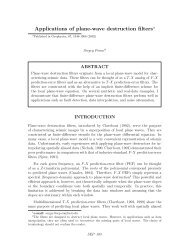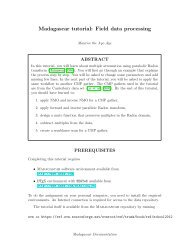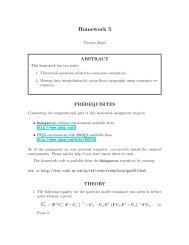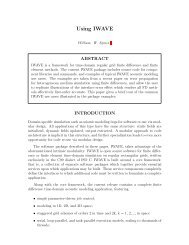Seismic wave extrapolation using lowrank symbol ... - Madagascar
Seismic wave extrapolation using lowrank symbol ... - Madagascar
Seismic wave extrapolation using lowrank symbol ... - Madagascar
Create successful ePaper yourself
Turn your PDF publications into a flip-book with our unique Google optimized e-Paper software.
Fomel, Ying, & Song 16 Lowrank <strong>wave</strong> <strong>extrapolation</strong><br />
Let N x be the number of samples both in space and <strong>wave</strong>number. Let us denote<br />
the samples in the spatial domain by x = {x 1 , . . . , x Nx } and the ones in the<br />
Fourier domain by k = {k 1 , . . . , k Nx }. The elements of the interaction matrix W<br />
from equation (11) are then defined as<br />
W ij = e ı[φ(x i,k j ,∆t]−x i·k j ] , 1 ≤ i, j ≤ N x . (A-1)<br />
Here we describe an algorithm by Engquist and Ying (2009) that generates, in a<br />
time linear with respect to N x , an approximate factorization of W of rank r in the<br />
following form<br />
W ≈ UMV ∗ ,<br />
(A-2)<br />
where U consists of r selected columns from W, M is a matrix of size r × r and V ∗<br />
consists of r selected rows from W.<br />
The first question is: which columns of W shall one pick for the matrix U? It<br />
has been shown by Goreinov et al. (1997) and Gu and Eisenstat (1996) that the r-<br />
dimensional volume spanned by these columns should be the maximum or close to the<br />
maximum among all possible choices of r columns from W. More precisely, suppose<br />
W = [w 1 , . . . , w Nx ] is a column partitioning of W. Then one aims to find {j 1 , . . . , j r }<br />
such that<br />
{j 1 , . . . , j r } = argmin {j1 ,...,j r}vol r (w j1 , . . . , w jr ). (A-3)<br />
However, finding a set of r columns with almost the maximum r-dimensional volume<br />
is a computationally difficult problem due to the following two reasons. First, the<br />
length of the vectors N is typically very large for three dimensional problems, hence<br />
manipulating these vectors can be costly. Second, the number of the vectors N x is also<br />
large. A exhaustive search over all possible choices of r vectors to find the one with<br />
the maximum volume is prohibitive expensive, so one needs to find a more practical<br />
approach.<br />
In order to overcome the problem associated with long vectors, the first idea is to<br />
project to a lower dimensional space and search for the set of vectors with maximum<br />
volume among the projected vectors. However, one needs to ensure that the volume<br />
is roughly preserved after the projection so that the set of vectors with the maximum<br />
projected volume also has a near-maximum volume in the original space. One of<br />
the most celebrated theorems in high dimensional geometry and probability is the<br />
following Johnson-Lindenstrauss lemma (Johnson and Lindenstrauss 1984).<br />
Theorem 1. Let v 1 , . . . , v N be a set of N vectors in R d . Let T be a randomly generated<br />
subspace of dimension t = O(log N/ε 2 ) and use P T to denote the orthogonal projection<br />
onto T . Then with high probability,<br />
for 1 ≤ i, j ≤ N.<br />
(1 − ε)‖v i − v j ‖ ≤<br />
√<br />
d<br />
t ‖P T v i − P T v j ‖ ≤ (1 + ε)‖v i − v j ‖











